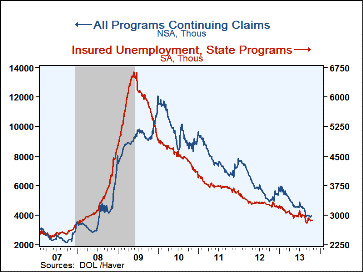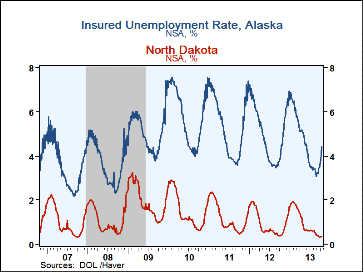 Global| Nov 07 2013
Global| Nov 07 2013U.S. Initial Jobless Claims Decline
Summary
Initial claims for unemployment insurance fell to 336,000 (-7.4% y/y) during the week ended November 2 from the previous week's 345,000, which was revised up 5,000 from its first report. The Labor Department indicated that the claims [...]
Initial claims for unemployment insurance fell to 336,000 (-7.4% y/y) during the week ended November 2 from the previous week's 345,000, which was revised up 5,000 from its first report. The Labor Department indicated that the claims processing difficulties in California have stopped affecting the data. The latest result was very close to consensus expectations of 335,000. The four-week moving average of initial claims decreased to 348,250 from the prior week's 357,250. During the last ten years there has been a 74% correlation between the level of claims and the m/m change in payroll employment.
Continuing claims for unemployment insurance in the week ended October 26 rose to 2.868 million (-10.1% y/y), but the prior week was revised down by 17,000 to 2.864 million. The figure remained up from the early-September low of 2.788 million. The four-week moving average of continuing claims eased to 2.866 million. The insured rate of unemployment remained at 2.2%, where it's been since late-August. This particular count covers only "regular" programs and does not include all extended benefit and other specialized jobless insurance programs. In the week of October 19, the latest available, the total of all benefit recipients rose to 3.959 million (-22.1% y/y). This broader measure is not seasonally adjusted. It compares to a cycle peak of 12.060 million in January 2010 and pre-recession figures that averaged 2.596 million for 2007. The number of individuals collecting emergency and extended payments in the week of October 19 increased to 1.371 million (-35.3% y/y) from a downward revised 1.305 million in the October 12 week, which is the low for the economic recovery.
By state, the insured rate of unemployment continued to vary greatly with North Dakota (0.36%), South Dakota (0.37%), Nebraska (0.85%), New Hampshire (1.04%), Utah (1.04%), Virginia (1.11%) and Florida (1.14%) at the low end of the range. At the high end were Illinois (2.39%), the District of Columbia (2.62%), Pennsylvania (2.70%), Connecticut (2.74%), California (2.99%), New Jersey (3.05%), and Alaska (4.45%). These data are not seasonally adjusted; the latest figures cover the October 19 week, with the October 26 state breakout due for release tomorrow.
Data on weekly unemployment insurance are contained in Haver's WEEKLY database and they are summarized monthly in USECON. Data for individual states are in REGIONW. The consensus estimates come from the Action Economics survey, carried in the AS1REPNA database.
| Unemployment Insurance (000s) | 11/02/13 | 10/26/13 | 10/19/13 | Y/Y % | 2012 | 2011 | 2010 |
|---|---|---|---|---|---|---|---|
| Initial Claims | 336 | 345 | 350 | -7.4 | 375 | 409 | 459 |
| Continuing Claims | -- | 2,868 | 2,864 | -10.1 | 3,318 | 3,744 | 4,544 |
| Insured Unemployment Rate (%) | -- | 2.2 | 2.2 | 2.5 (10/12) |
2.6 | 3.0 | 3.6 |
| Total "All Programs" (NSA) | -- | -- | 3.959 mil. | -22.1 | 6.047 mil. | 7.750 mil. | 9.850 mil. |
Carol Stone, CBE
AuthorMore in Author Profile »Carol Stone, CBE came to Haver Analytics in 2003 following more than 35 years as a financial market economist at major Wall Street financial institutions, most especially Merrill Lynch and Nomura Securities. She has broad experience in analysis and forecasting of flow-of-funds accounts, the federal budget and Federal Reserve operations. At Nomura Securites, among other duties, she developed various indicator forecasting tools and edited a daily global publication produced in London and New York for readers in Tokyo. At Haver Analytics, Carol is a member of the Research Department, aiding database managers with research and documentation efforts, as well as posting commentary on select economic reports. In addition, she conducts Ways-of-the-World, a blog on economic issues for an Episcopal-Church-affiliated website, The Geranium Farm. During her career, Carol served as an officer of the Money Marketeers and the Downtown Economists Club. She has a PhD from NYU's Stern School of Business. She lives in Brooklyn, New York, and has a weekend home on Long Island.









